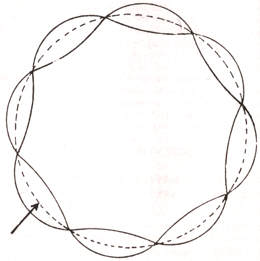
Atoms of Democritus were all of the same substance but had different sizes and shapes. They were eternally unchanging (Parmenidian), impenetrable and indivisible. Atoms themselves had neither colour nor smell nor taste, the sensuousness of the material objects being produced by the motion and arrangement of atoms in space.
“Sweet and bitter, cold and warm as well as all the colours, all these things exist but in opinion and not in reality, what really exists are unchangeable particles, atoms and their motions in empty space" wrote Democritus.
We now know that the object which were referred to as 'atoms' historically and later during the revival of science in seventeenth century, are not indivisible units of matter. According to the modern science, the atom of a chemical element is rather a complicated system of smaller units such as protons, neutrons, electrons, etc. which are now called subatomic particles. The number of such subatomic particles has now crossed the figure 200.
 It has been established beyond doubt that atoms of various chemical elements are very much similar to our solar system, with a number of negatively charged particles (electrons) rotating round the central nucleus in the form of standing waves, which itself is composed of a number of positively charged particles (protons) and electrically neutral particles (neutrons). Protons and neutrons are much heavier than electrons so that the nucleus contain 99.97% of the total atomic mass. The number of protons, neutrons, electrons are different in different elements but the atom on the whole is electrically neutral because the total change of all negatively charged particles equals the total positive charge.
It has been established beyond doubt that atoms of various chemical elements are very much similar to our solar system, with a number of negatively charged particles (electrons) rotating round the central nucleus in the form of standing waves, which itself is composed of a number of positively charged particles (protons) and electrically neutral particles (neutrons). Protons and neutrons are much heavier than electrons so that the nucleus contain 99.97% of the total atomic mass. The number of protons, neutrons, electrons are different in different elements but the atom on the whole is electrically neutral because the total change of all negatively charged particles equals the total positive charge.
The simplest and lightest atom is that of hydrogen. It is composed of a single proton as the nucleus and a single electron orbiting round it. Its diameter is 10-8 centimeter and mass 1.64xl0-23 grammes. The distance between the nucleus and the rotating electron is such that the atomic diameter is 1,00,000 times greater than the diameter of the nucleus. In the atom of uranium, which is the heaviest natural element, there are as many as 92 protons and 146 neutrons in the nucleus and 92 electrons rotate round it in different orbits.
Later on, theoretical physicists branched into two schools. One of them continued their search for the elementary building blocks, as they were not satisfied that subatomic particles such as protons, neutrons, etc. were indivisible, while the other one abandoned their search. Although no one has so far found the particles, which composed the protons, theoretically it has been established that the protons are composed of 'quarks'. The hunt for quarks is going on. But, whether they do actually exist or not, one thing is already certain, viz., a new area of research 'what are quarks made of’ has emerged.
 Jethalal S. Zaveri
Jethalal S. Zaveri
 Prof. Muni Mahendra Kumar
Prof. Muni Mahendra Kumar

